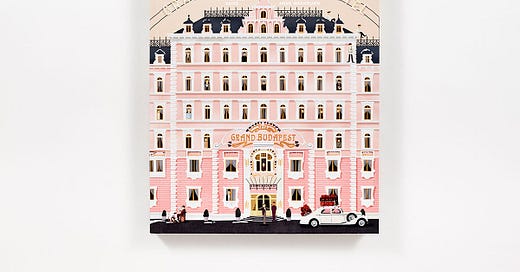Dear Valued Guests,
We have reached the penultimate film in our Hotel Movie series — and the second film to have “hotel” smushed right into the title. “The Grand Budapest Hotel” is very different, however, from “Grand Hotel,” despite their overlapping words and time periods. “Grand Hotel” is a messy sprawl of a thing, bulging out of its schmancy Berlin trappings like an overstuffed eclair; only Greta Garbo shows some modicum of restraint in it, and even so she’s as broad as she has ever been. “The Grand Budapest Hotel” is, in classical Wes Anderson fashion, a highly composed coffret, a persnickety diorama in which each element has been meticulously placed with tweezers. Don’t get me wrong, TGBH is also sprawling, insomuch as Anderson shoves seventeen castmembers into an ensemble and has them play out an increasingly intricate murder mystery scenario as WWII and its attendant dangers looms around the corner. But an Anderson film never truly goes off the rails, not gloriously, anyway. His taste is far too completist for that, far too compact and jewel-like and sewn together just so. He never lets the seed pearls of his vision scatter across the floor; each pearl is placed, polished, and put on gallery display. Anderson is a controversial filmmaker, not because his films have all too much to say politically, but because their politics are entirely those of style. For Anderson, style is substance, substance is a style, and function follows form entirely. Without twee little pastries in perfect shades of pistachio green and eraser pink, there is no story. The pastries are the story. They are the reason we have all gathered: to see the perfect sugar shells and marvel at what wonders we as a species can produce when we put our minds to it.
I often find myself taking a position to defend Anderson against his naysayers, being a person who is intensely interested in style myself — though even I will admit that sometimes the work can feel exhausting in its specificity, like staying slightly too long at a museum. What was once enthralling starts to seem tedious, and all you want is a soft place to sit down and a cup of coffee. I work at the New Yorker, and I still found “The Paris Dispatch” to be a bit too precious about the delicate machinations of putting together such a magazine. But of course, I will always love Margot Tenenbaum and her kohl-rimmed eyes, and the cherry red beanies from “The Life Aquatic,” and the teensy felted flags from “Moonrise Kingdom.” He makes indelible images, you must admit, and with such devotion that there are entire Instagram accounts (and now coffee table books) devoted to things in the real world that accidentally appear as if Anderson conjured them. “The Grand Budapest Hotel” may be one of Anderson’s most pleasing visual efforts, because it has a sense of consonance to it. The laboring over looks is not extraneous, as the film’s very environment (an Alpine auberge) is supposed to be fussy and overworked, manicured and maintained. Ralph Fiennes serves as the scrupulous concierge who presides over this order, and by extension his Gustave H. serves as an in-film cipher for Anderson’s own obsessive attention to detail (could Anderson have made “The Menu?” Discuss.). TGBH is a film about struggling to maintain quality in the face of encroaching entropy, which is also more or less what making a movie is like.
If you want to read more about the film and its pastel aesthetic commitments, I highly recommend Matt Zoller Seitz’s coffee table book about it, which has the benefit of looking like a lovely pink cake sitting in your living room. You can also read more about Stefan Zweig, an Austrian critic and novelist whose writing inspired the film, by reading Leo Carey’s devastating New Yorker piece about his life and death, George Prochnik’s biography, or, one of my own favorite short books, Volker Weidermann’s Ostend, a slim work of fiction that imagines the summer that Zweig spent living by the beach before things in Europe became impossibly grim.
And if you just want a laugh…
See you shortly for bellhops and dubious old ladies. I’ll be the one holding the Mendl’s box.
—The Management





Just came across this Substack and delighted to read about Grand Budapest Hotel first! It was my introduction to Wes Anderson and I've come to appreciate his aesthetic sense more over the years. I also adored Matt Zoller Seitz's book that I came across last year with all its wonderful illustrations to match the movies.
I didn't enjoy The French Dispatch quite as much as his other films too but I do love the attention to detail and dedication to visual elements which are always present in his work.